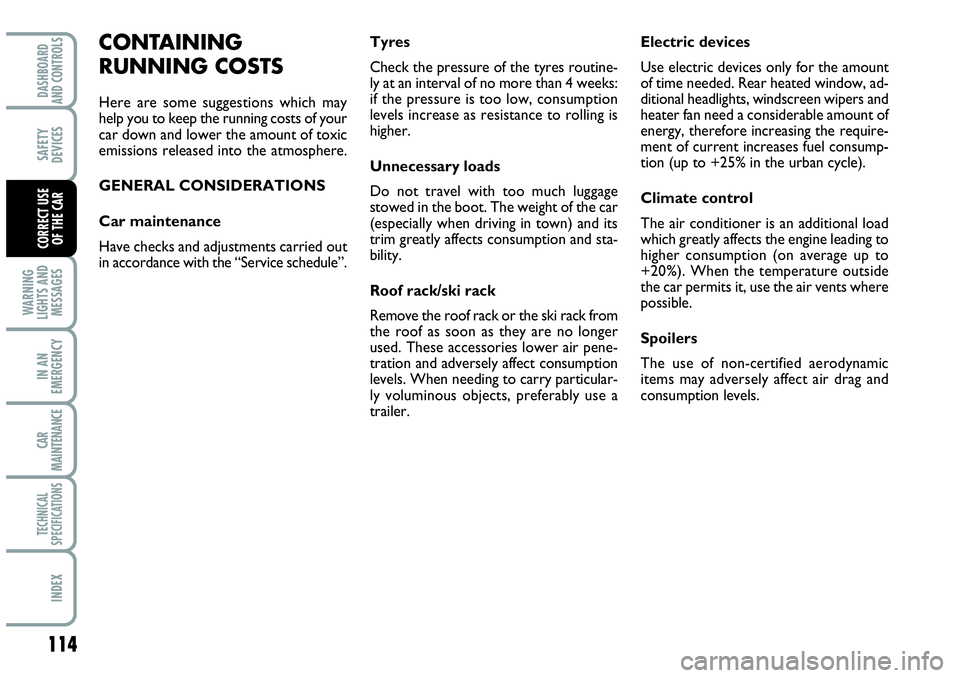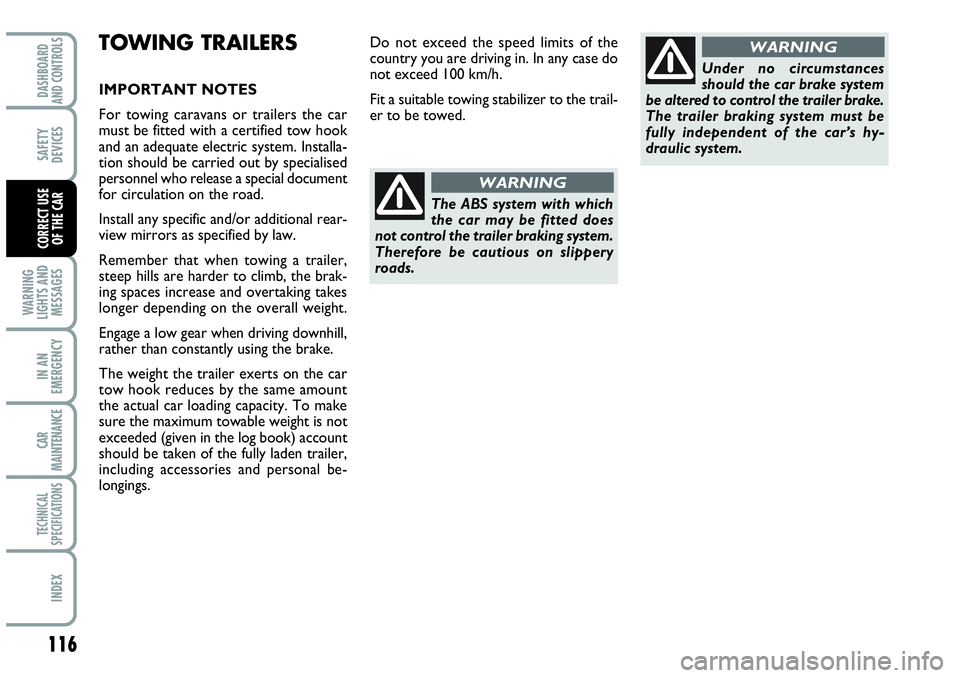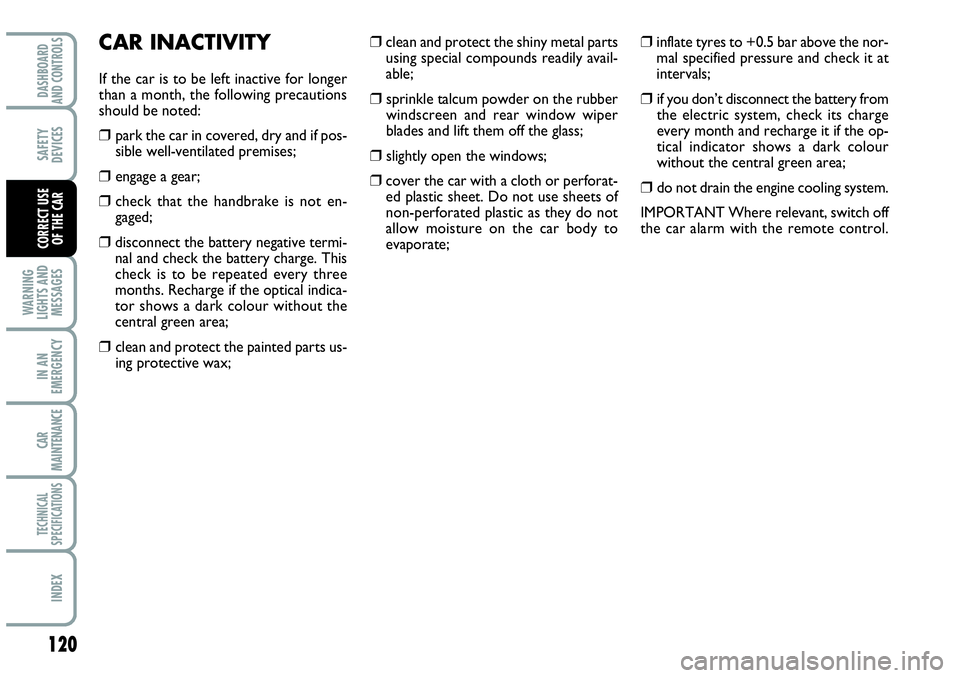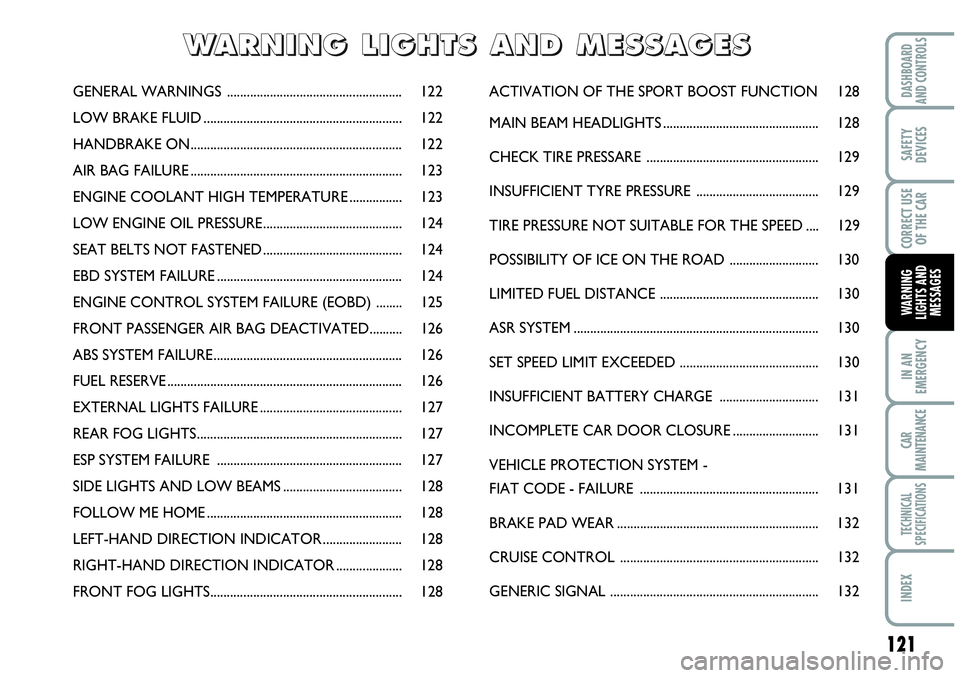technical specifications Abarth Grande Punto 2010 Owner handbook (in English)
[x] Cancel search | Manufacturer: ABARTH, Model Year: 2010, Model line: Grande Punto, Model: Abarth Grande Punto 2010Pages: 207, PDF Size: 3.01 MB
Page 116 of 207

114
WARNING
LIGHTS AND
MESSAGES
IN AN
EMERGENCY
CAR
MAINTENANCE
TECHNICAL
SPECIFICATIONS
INDEX
DASHBOARD
AND CONTROLS
SAFETY
DEVICES
CORRECT USE
OF THE CAR
CONTAINING
RUNNING COSTS
Here are some suggestions which may
help you to keep the running costs of your
car down and lower the amount of toxic
emissions released into the atmosphere.
GENERAL CONSIDERATIONS
Car maintenance
Have checks and adjustments carried out
in accordance with the “Service schedule”.Tyres
Check the pressure of the tyres routine-
ly at an interval of no more than 4 weeks:
if the pressure is too low, consumption
levels increase as resistance to rolling is
higher.
Unnecessary loads
Do not travel with too much luggage
stowed in the boot. The weight of the car
(especially when driving in town) and its
trim greatly affects consumption and sta-
bility.
Roof rack/ski rack
Remove the roof rack or the ski rack from
the roof as soon as they are no longer
used. These accessories lower air pene-
tration and adversely affect consumption
levels. When needing to carry particular-
ly voluminous objects, preferably use a
trailer.Electric devices
Use electric devices only for the amount
of time needed. Rear heated window, ad-
ditional headlights, windscreen wipers and
heater fan need a considerable amount of
energy, therefore increasing the require-
ment of current increases fuel consump-
tion (up to +25% in the urban cycle).
Climate control
The air conditioner is an additional load
which greatly affects the engine leading to
higher consumption (on average up to
+20%). When the temperature outside
the car permits it, use the air vents where
possible.
Spoilers
The use of non-certified aerodynamic
items may adversely affect air drag and
consumption levels.
Page 117 of 207

115
WARNING
LIGHTS AND
MESSAGES
IN AN
EMERGENCY
CAR
MAINTENANCE
TECHNICAL
SPECIFICATIONS
INDEX
DASHBOARD
AND CONTROLS
SAFETY
DEVICES
CORRECT USE
OF THE CAR
DRIVING STYLE
Starting
Do not warm the engine with the car at
a standstill or at idle or high speed: under
these conditions the engine warms up
much more slowly, increasing electrical
consumption and emissions. It is therefore
advisable to move off immediately, slow-
ly, avoiding high speeds. This way the en-
gine will warm faster.
Unnecessary actions
Avoid accelerating when waiting at traffic
lights or before switching off the engine.
This and also double declutching is ab-
solutely pointless on modern cars and al-
so increase consumption and pollution.CONDITIONS OF USE
Cold starting
Short journeys and frequent cold starts do
not allow the engine to reach optimum op-
erating temperature. This results in a sig-
nificant increase in consumption levels
(from +15 to +30% on the urban cycle)
and emission of harmful substances.
Traffic and road conditions
Rather high consumption levels are tied to
situations with heavy traffic, for example
in queues with frequent use of the lower
gears or in cities with many traffic lights.
Also winding mountain roads and rough
road surfaces adversely affect consump-
tion.
Traffic hold-ups
During prolonged hold-ups (level crossings)
the engine should be switched off. Gear selection
As soon as the conditions of the traffic and
road allow, use a higher gear. Using a low
gear to obtain brilliant performance in-
creases consumption.
In the same way improper use of a high
gear increases consumption, emissions an
engine wear.
Top speed
Fuel consumption considerably increases
with speed. Avoid superfluous braking and
accelerating, which cost in terms of both
fuel and emissions.
Acceleration
Accelerating violently increasing the revs
will greatly affect consumption and emis-
sions: acceleration should be gradual and
should not exceed the maximum torque.
Page 118 of 207

116
WARNING
LIGHTS AND
MESSAGES
IN AN
EMERGENCY
CAR
MAINTENANCE
TECHNICAL
SPECIFICATIONS
INDEX
DASHBOARD
AND CONTROLS
SAFETY
DEVICES
CORRECT USE
OF THE CAR
Do not exceed the speed limits of the
country you are driving in. In any case do
not exceed 100 km/h.
Fit a suitable towing stabilizer to the trail-
er to be towed.TOWING TRAILERS
IMPORTANT NOTES
For towing caravans or trailers the car
must be fitted with a certified tow hook
and an adequate electric system. Installa-
tion should be carried out by specialised
personnel who release a special document
for circulation on the road.
Install any specific and/or additional rear-
view mirrors as specified by law.
Remember that when towing a trailer,
steep hills are harder to climb, the brak-
ing spaces increase and overtaking takes
longer depending on the overall weight.
Engage a low gear when driving downhill,
rather than constantly using the brake.
The weight the trailer exerts on the car
tow hook reduces by the same amount
the actual car loading capacity. To make
sure the maximum towable weight is not
exceeded (given in the log book) account
should be taken of the fully laden trailer,
including accessories and personal be-
longings.
The ABS system with which
the car may be fitted does
not control the trailer braking system.
Therefore be cautious on slippery
roads.
WARNING
Under no circumstances
should the car brake system
be altered to control the trailer brake.
The trailer braking system must be
fully independent of the car’s hy-
draulic system.
WARNING
Page 119 of 207

117
WARNING
LIGHTS AND
MESSAGES
IN AN
EMERGENCY
CAR
MAINTENANCE
TECHNICAL
SPECIFICATIONS
INDEX
DASHBOARD
AND CONTROLS
SAFETY
DEVICES
CORRECT USE
OF THE CAR
For the electric connection a unified con-
nector should be used which is generally
placed on a special bracket normally fas-
tened to the towing device, and a special
ECU for external trailer light control shall
be installed on the car.
For the electrical connection, 7 or 13 pin
12VDC connection is to be used (CU-
NA/UNI and ISO/DIN Standards). Follow
the instructions provided by the car man-
ufacturer and/or the tow hitch manufac-
turer.An electric brake should be supplied di-
rectly by the battery through a cable with
a cross section of no less than 2.5 mm
2.
IMPORTANT Electric brake or other de-
vice shall be used with running engine.
In addition to the electrical branches, the
car’s electric system can only be con-
nected to the supply cable for an electric
brake and to the cable for an internal light,
though not above 15W.
For connections use the preset control
unit with battery cable no less than 2.5
mm
2. INSTALLING THE TOW HOOK
The towing device should be fastened to
the body by specialised personnel accord-
ing to any additional and/or integrative in-
formation supplied by the Manufacturer of
the device.
The towing device must meet current reg-
ulations with reference to 94/20/EC Di-
rective and subsequent amendments.
For any version the towing device used
must match the towable weight of the car
on which it is to be installed.
Page 120 of 207

118
WARNING
LIGHTS AND
MESSAGES
IN AN
EMERGENCY
CAR
MAINTENANCE
TECHNICAL
SPECIFICATIONS
INDEX
DASHBOARD
AND CONTROLS
SAFETY
DEVICES
CORRECT USE
OF THE CAR
Assembly diagram fig. 3
The tow hook structure must be fastened
in the points shown by the symbol
Øus-
ing a total of 6 M10 screws.
The internal counterplates are to be at
least 6 mm thick.
IMPORTANT It is compulsory to fasten a
label (plainly visible) of suitable size and
material with the following wording:
MAX LOAD ON BALL 60 kg
After fitting, screw holes
shall be sealed to prevent ex-
haust gas inlet.
WARNING
fig. 3F0M092Ab
Existing
hole
Existing
screw
Existing
screw
Existing
holeExisting
hole
Existing hole
Standard tow ball
Full load
Page 121 of 207

119
WARNING
LIGHTS AND
MESSAGES
IN AN
EMERGENCY
CAR
MAINTENANCE
TECHNICAL
SPECIFICATIONS
INDEX
DASHBOARD
AND CONTROLS
SAFETY
DEVICES
CORRECT USE
OF THE CAR
SNOW CHAINS
Use of snow chains should be in compli-
ance with local regulations.
Snow chains should only be applied to the
driving wheels (front wheels). We rec-
ommend using Lineaccessori Abarth snow
chains.
Check the tension of the chains after the
first few metres have been driven.
IMPORTANT With snow chains, use the
accelerator with extreme care to prevent
or to limit as much as possible slipping of
the driving wheels that could cause chain
breaking resulting in damages to the car
body or mechanical components.
IMPORTANT Use 9 mm reduced size
snow chains.Keep your speed down when
snow chains are fitted. Do
not exceed 50 km/h. Avoid
potholes, steps and pave-
ments and avoid also to dri-
ve for long distances on
roads not covered with snow to pre-
vent damaging the car and the
roadbed.
WARNING
The 215/45 R17 91Y pneu-
matic is not suitable to have
chains on.
WARNING
Page 122 of 207

120
WARNING
LIGHTS AND
MESSAGES
IN AN
EMERGENCY
CAR
MAINTENANCE
TECHNICAL
SPECIFICATIONS
INDEX
DASHBOARD
AND CONTROLS
SAFETY
DEVICES
CORRECT USE
OF THE CAR
CAR INACTIVITY
If the car is to be left inactive for longer
than a month, the following precautions
should be noted:
❒ park the car in covered, dry and if pos-
sible well-ventilated premises;
❒ engage a gear;
❒ check that the handbrake is not en-
gaged;
❒disconnect the battery negative termi-
nal and check the battery charge. This
check is to be repeated every three
months. Recharge if the optical indica-
tor shows a dark colour without the
central green area;
❒ clean and protect the painted parts us-
ing protective wax;
❒clean and protect the shiny metal parts
using special compounds readily avail-
able;
❒ sprinkle talcum powder on the rubber
windscreen and rear window wiper
blades and lift them off the glass;
❒ slightly open the windows;
❒cover the car with a cloth or perforat-
ed plastic sheet. Do not use sheets of
non-perforated plastic as they do not
allow moisture on the car body to
evaporate;
❒inflate tyres to +0.5 bar above the nor-
mal specified pressure and check it at
intervals;
❒ if you don’t disconnect the battery from
the electric system, check its charge
every month and recharge it if the op-
tical indicator shows a dark colour
without the central green area;
❒ do not drain the engine cooling system.
IMPORTANT Where relevant, switch off
the car alarm with the remote control.
Page 123 of 207

121
IN AN
EMERGENCY
CAR
MAINTENANCE
TECHNICAL
SPECIFICATIONS
INDEX
DASHBOARD
AND CONTROLS
SAFETY
DEVICES
CORRECT USE
OF THE CAR
WARNING
LIGHTS AND
MESSAGES
GENERAL WARNINGS ..................................................... 122
LOW BRAKE FLUID............................................................ 122
HANDBRAKE ON................................................................ 122
AIR BAG FAILURE ................................................................ 123
ENGINE COOLANT HIGH TEMPERATURE ................ 123
LOW ENGINE OIL PRESSURE.......................................... 124
SEAT BELTS NOT FASTENED .......................................... 124
EBD SYSTEM FAILURE ........................................................ 124
ENGINE CONTROL SYSTEM FAILURE (EOBD) ........ 125
FRONT PASSENGER AIR BAG DEACTIVATED.......... 126
ABS SYSTEM FAILURE......................................................... 126
FUEL RESERVE ....................................................................... 126
EXTERNAL LIGHTS FAILURE........................................... 127
REAR FOG LIGHTS.............................................................. 127
ESP SYSTEM FAILURE ........................................................ 127
SIDE LIGHTS AND LOW BEAMS.................................... 128
FOLLOW ME HOME ........................................................... 128
LEFT-HAND DIRECTION INDICATOR ........................ 128
RIGHT-HAND DIRECTION INDICATOR .................... 128
FRONT FOG LIGHTS.......................................................... 128ACTIVATION OF THE SPORT BOOST FUNCTION 128
MAIN BEAM HEADLIGHTS............................................... 128
CHECK TIRE PRESSARE .................................................... 129
INSUFFICIENT TYRE PRESSURE ..................................... 129
TIRE PRESSURE NOT SUITABLE FOR THE SPEED .... 129
POSSIBILITY OF ICE ON THE ROAD ........................... 130
LIMITED FUEL DISTANCE ................................................ 130
ASR SYSTEM.......................................................................... 130
SET SPEED LIMIT EXCEEDED .......................................... 130
INSUFFICIENT BATTERY CHARGE .............................. 131
INCOMPLETE CAR DOOR CLOSURE .......................... 131
VEHICLE PROTECTION SYSTEM -
FIAT CODE - FAILURE ...................................................... 131
BRAKE PAD WEAR ............................................................. 132
CRUISE CONTROL ............................................................ 132
GENERIC SIGNAL ............................................................... 132
W W
A A
R R
N N
I I
N N
G G
L L
I I
G G
H H
T T
S S
A A
N N
D D
M M
E E
S S
S S
A A
G G
E E
S S
Page 124 of 207

122
IN AN
EMERGENCY
CAR
MAINTENANCE
TECHNICAL
SPECIFICATIONS
INDEX
DASHBOARD
AND CONTROLS
SAFETY
DEVICES
CORRECT USE
OF THE CAR
WARNING
LIGHTS AND
MESSAGES
WARNING LIGHTS
AND MESSAGES
GENERAL WARNINGS
Turning on of warning light is accompa-
nied by specific message and/or by buzzer
sound where provided by instrument pan-
el. These indications are concise and
cautionaryand shall not be considered
as exhaustive and/or as an alternative to
the specifications contained in this Own-
er Handbook which shall always be read
through carefully and thoroughly. In case
of failure indication always refer to the
specifications contained in this sec-
tion.
IMPORTANT Failure indications displayed
are divided into two categories: very se-
riousand less seriousfailures.
Very seriousfailures are indicated by a
repeated and prolonged warning “cycle”.
Less seriousfailures are indicated by a lim-
ited warning “cycle”.
The warning cycle of both failure cate-
gories can be stopped by pressing button
MENU ESC. The instrument panel warn-
ing light will stay on until eliminating the
fault.LOW BRAKE FLUID
(red)
HANDBRAKE ON (red)
Turning the ignition key in the MARpo-
sition the warning light turns on, it has
to turn off after a few seconds.
Insufficient brake fluid
The warning light turns on when the lev-
el of the brake fluid in the reservoir drops
under the minimum level, due to a prob-
able loss of fluid from the circuit.
The display visualizes the specific message.
x
If the warning light xturns
on (together with the mes-
sage on the display) while driving,
stop immediately and refer to the
Abarth technical assistance network.
WARNING
Hand brake engaged
The light turns on when the hand brake
is engaged.
If the car is in motion, on some versions
there also is an associated acoustic warn-
ing signal.
IMPORTANT If the light turns on while
the car is in motion, check that the hand
brake is not engaged.
Page 125 of 207

123
IN AN
EMERGENCY
CAR
MAINTENANCE
TECHNICAL
SPECIFICATIONS
INDEX
DASHBOARD
AND CONTROLS
SAFETY
DEVICES
CORRECT USE
OF THE CAR
WARNING
LIGHTS AND
MESSAGES
AIR BAG FAILURE (red)
Turning the ignition key in the
MARposition the warning
light turns on, it has to turn off
after a few seconds.
If the warning light does not turn off this
indicates a failure in the air bag system.
The display visualizes the specific message.
¬
If the ¬warning light does
not turn on while turning the
ignition key in the MAR position or
if it stays lighted while the car is in
motion there may be a failure in the
restraint systems; in this case the air
bags or the pretensioners may be de-
activated in the event of a collision
or, in a limited number of cases, ac-
tivate incorrectly. Before going on re-
fer to the Abarth Dealership in order
to have the system immediately in-
spected.
WARNING
The ¬warning light failure
(light off ) is signalled by the
flashing for over the normal 4 seconds
of the light “that signals that the
passenger-side air bag is deactivated.
WARNING
ENGINE COOLANT
HIGH TEMPERATURE
(red)
Turning the ignition key in the
MARposition the warning light turns on,
it has to turn off after a few seconds.
The light turns on when the engine is
overheated.
If the light turns on the following steps
must be followed:
❒if in normal driving conditions:
stop the vehicle, turn off the engine
and check that the water level in the
reservoir is not under the MINmark.
In this case wait a few minutes in or-
der to let the engine cool down, then
open slowly and very carefully the tap,
fill up with the coolant, making sure
that the coolant level is between the
MINand MAXmarks on the reser-
voir. Besides visually check the pres-
ence of possible leaks of coolant. If the
light turns on again after starting up
the engine refer to the Abarth Deal-
ership.
ç
❒in case of demanding use of the
vehicle(for example during uphill
hauling of trailers or when the vehi-
cle is fully loaded): slow down and, if
the light stays on, halt the car. Stop for
2 or 3 minutes keeping the engine on
and slightly revved up in order to
favour the active circulation of the
coolant, after that turn off the engine.
Check the level of the coolant in the
reservoir as previously described.
IMPORTANT In case of very exacting
routes it is advisable before turning off the
engine to keep it on and slightly revved up
for a few minutes.
The display visualizes the specific message.